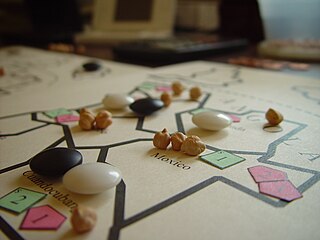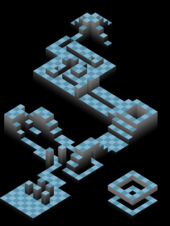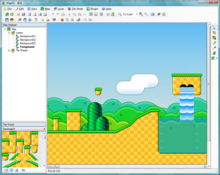
Rise of the Triad: Dark War is a first-person shooter video game, developed and published by Apogee Software in 1995. The player can choose one of five different characters to play as, each bearing unique attributes such as height, speed, and endurance. The game's story follows these five characters who have been sent to investigate a deadly cult, and soon become aware of a deadly plot to destroy a nearby city. Its remake was designed by Interceptor Entertainment and released by Apogee Games in 2013. The shareware version of the game is titled Rise of the Triad: The HUNT Begins.

SimCity 4 is a city-building simulation computer game developed by Maxis, a subsidiary of Electronic Arts. The game was released in January 2003 for Microsoft Windows and in June 2003 for Mac OS X. It is the fourth major installment in the SimCity series. SimCity 4 has a single expansion pack called Rush Hour which adds features to the game. SimCity 4: Deluxe Edition contained the original game and Rush Hour combined as a single product.
A game programmer is a software engineer, programmer, or computer scientist who primarily develops codebases for video games or related software, such as game development tools. Game programming has many specialized disciplines, all of which fall under the umbrella term of "game programmer". A game programmer should not be confused with a game designer, who works on game design.
An action game is a video game genre that emphasizes physical challenges, including hand–eye coordination and reaction time. The genre includes a large variety of sub-genres, such as fighting games, beat 'em ups, shooter games, rhythm games and platform games. Multiplayer online battle arena and some real-time strategy games are also considered action games.
Video game design is the process of designing the rules and content of video games in the pre-production stage and designing the gameplay, environment, storyline and characters in the production stage. Some common video game design subdisciplines are world design, level design, system design, content design, and user interface design. Within the video game industry, video game design is usually just referred to as "game design", which is a more general term elsewhere.

A minigame is a short game often contained within another video game. A minigame contains different gameplay elements and is often smaller or more simplistic than the game in which it is contained.
Video game development is the process of creating a video game. It is a multidisciplinary practice, involving programming, design, art, audio, user interface, and writing. Each of those may be made up of more specialized skills; art includes 3D modeling of objects, character modeling, animation, visual effects, and so on. Development is supported by project management, production, and quality assurance. Teams can be many hundreds of people, a small group, or even a single person.
Emergent gameplay refers to complex situations in video games, board games, or role-playing games that emerge from the interaction of relatively simple game mechanics.
The following outline is provided as an overview of and topical guide to video games:
Game testing, also called quality assurance (QA) testing within the video game industry, is a software testing process for quality control of video games. The primary function of game testing is the discovery and documentation of software defects. Interactive entertainment software testing is a highly technical field requiring computing expertise, analytic competence, critical evaluation skills, and endurance. In recent years the field of game testing has come under fire for being extremely strenuous and unrewarding, both financially and emotionally.

Jurassic Park Interactive is an action video game based on the 1993 movie Jurassic Park. It was released in North America on May 10, 1994 exclusively for the 3DO Interactive Multiplayer by Universal Interactive Studios. Jurassic Park Interactive was the first video game released by Universal Interactive Studios.

Super Mario is a platform game series created by Nintendo starring their mascot, Mario. It is the central series of the greater Mario franchise. At least one Super Mario game has been released for every major Nintendo video game console. However, there have also been a number of Super Mario video games released on non-Nintendo gaming platforms. There are more than 20 games in the series.

In video games, an open world is a virtual world in which the player can approach objectives freely, as opposed to a world with more linear and structured gameplay. Notable games in this category include The Legend of Zelda (1986), Grand Theft Auto V (2013) and Minecraft (2011).

A loading screen is a screen shown by a computer program, very often a video game, while the program is loading or initializing.

A game design document is a highly descriptive living software design document of the design for a video game. A GDD is created and edited by the development team and it is primarily used in the video game industry to organize efforts within a development team. The document is created by the development team as result of collaboration between their designers, artists and programmers as a guiding vision which is used throughout the game development process. When a game is commissioned by a game publisher to the development team, the document must be created by the development team and it is often attached to the agreement between publisher and developer; the developer has to adhere to the GDD during game development process.
Game art design is a subset of game development involving the process of creating the artistic aspects of video games. Video game art design begins in the pre-production phase of creating a video game. Video game artists are visual artists involved from the conception of the game who make rough sketches of the characters, setting, objects, etc. These starting concept designs can also be created by the game designers before the game is moved into actualization. Sometimes, these concept designs are called "programmer art". After the rough sketches are completed and the game is ready to be moved forward, those artists or more artists are brought in to develop graphic designs based on the sketches.
This is a non-comprehensive list that includes terms used in video games and the video game industry, as well as slang used by players.

Ancient Trader is a turn-based strategy video game developed by the Slovakian studio 4Kids Games. It was released in 2010 for Microsoft Windows, Xbox Live on Xbox 360, and iOS. The player controls a ship, allowing them to explore the world and engage in trading while seeking three artifacts that will help to defeat the game's main antagonist, a sea creature called the Ancient Guardian.

Game design is the process of creating and shaping the mechanics, systems and rules of a game. Games can be created for entertainment, education, exercise or experimental purposes. Additionally, elements and principles of game design can be applied to other interactions, in the form of gamification. Game designer and developer Robert Zubek defines game design by breaking it down into its elements, which he says are the following:

Metroidvania is a sub-genre of action-adventure games and/or platformers focused on guided non-linearity and utility-gated exploration and progression. The term is a portmanteau of the names of the video game series Metroid and Castlevania, based on the template from Metroid (1986), Castlevania II (1987), Super Metroid (1994), and Castlevania: Symphony of the Night (1997).















